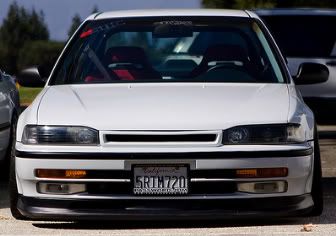This might warrant a sticky.
I'm bored and alot of people don't seem to get this concept, so here we go.
What is ride frequency and what does it mean to me?
The ride frequency of a car is the rate in Hertz (Hz) that a suspension oscillates up and down. The higher the ride frequency (RF for now on), the stiffer the ride usually is. RF and spring rate are related, but not how most people think. Technically speaking, you can't compare spring rates between cars to gauge ride harshness. Example: A 500lb spring on your CB7 and a 500lb spring on Joe's mustang will not feel the same.
Why is that?
RF is influenced by several factors which include total weight, unsprung mass, spring rate, and motion ratio (and technically tire spring rate). Now for some definitions:
Lets focus on a single corner of the car...
Total weight: Weight on that corner, self explanatory
Unsprung mass: Things not supported by the suspension. This includes wheels, tires, brakes (rotors, calipers, pads, etc) and a portion of the spring, shock, and control arm. The entire upright (aka knuckle) and hub and bearing is counted though.
Spring rate: Given in lbs/in or kg/mm. This is how stiff your spring is. Example: A 500lbs/in spring means it takes 500 lbs on the spring to compress it 1 inch....you maybe start to see how to calculate how much a spring of given dimensions will lower the vehicle.
Motion ratio: This is a number between 0 and 1. It is the ratio of how much the spring & damper moves vs how much the wheel moves upward. Example: If your tire moves up one inch, and the suspension moves up 0.7 inches, you have a motion ratio of 0.7.
Tire spring rate: Same idea as normal spring rate, but many factors of the tire itself determine this, including air pressure inside the tire. Sometimes you can find this info for tires like Hoosier's, but a typical street tire you just have to either calculate it directly, estimate, or leave it out of your calculations.
So, you can see that if two cars with different motion ratios and different unsprung weights have the same springs, the ride frequencies will be different. While you cannot compare spring rates between the CB7 and the mustang, you CAN compare ride frequencies. A ride frequency of 1.7 Hz in the CB7 and the mustang will feel the exact same(provided the dampers are the same).
Ok that's great, why do I care about ride frequency?
We'll tackle this with a pro's and con's list:
<1.0 Hz, for typical street cars)
1.0 - 1.5 Hz, high performance cars probably where alot of us want to be that care
>1.5 Hz, race cars only, your kidneys will hate you forever.
Low ride frequency
Pros:
Ride comfort
More mechanical grip
Aids in damper effectiveness
Cons:
Too low may result in bottoming out
Less responsive
Decreased roll stiffness
High ride frequency
Pros:
Safer to go lower
Faster transient response
Increased roll stiffness
Cons:
Decrease in mechanical grip, car may begin to "skate"
Decreased ride comfort
Damper adjustments become less precise/effective
As you can see, there are compromises. The one thing that is almost never a compromise though is reducing unsprung mass. Less unsprung mass allows you to retain the same RF with a softer spring, and in the case of wheels and brakes, less weight makes it easier to accelerate the rotating components as well as slow them down. The only downside is if you sacrifice braking performance by going to a lighter, smaller braking system. If you can get a lighter caliper, lighter wheels, lighter control arms, etc...do it. It's almost always a good idea.
I'm not going to say what suspension you should get, hopefully you can decide that on your own and this helps you to do that.
I'll probably add more later.
I'm bored and alot of people don't seem to get this concept, so here we go.
What is ride frequency and what does it mean to me?
The ride frequency of a car is the rate in Hertz (Hz) that a suspension oscillates up and down. The higher the ride frequency (RF for now on), the stiffer the ride usually is. RF and spring rate are related, but not how most people think. Technically speaking, you can't compare spring rates between cars to gauge ride harshness. Example: A 500lb spring on your CB7 and a 500lb spring on Joe's mustang will not feel the same.
Why is that?
RF is influenced by several factors which include total weight, unsprung mass, spring rate, and motion ratio (and technically tire spring rate). Now for some definitions:
Lets focus on a single corner of the car...
Total weight: Weight on that corner, self explanatory
Unsprung mass: Things not supported by the suspension. This includes wheels, tires, brakes (rotors, calipers, pads, etc) and a portion of the spring, shock, and control arm. The entire upright (aka knuckle) and hub and bearing is counted though.
Spring rate: Given in lbs/in or kg/mm. This is how stiff your spring is. Example: A 500lbs/in spring means it takes 500 lbs on the spring to compress it 1 inch....you maybe start to see how to calculate how much a spring of given dimensions will lower the vehicle.
Motion ratio: This is a number between 0 and 1. It is the ratio of how much the spring & damper moves vs how much the wheel moves upward. Example: If your tire moves up one inch, and the suspension moves up 0.7 inches, you have a motion ratio of 0.7.
Tire spring rate: Same idea as normal spring rate, but many factors of the tire itself determine this, including air pressure inside the tire. Sometimes you can find this info for tires like Hoosier's, but a typical street tire you just have to either calculate it directly, estimate, or leave it out of your calculations.
So, you can see that if two cars with different motion ratios and different unsprung weights have the same springs, the ride frequencies will be different. While you cannot compare spring rates between the CB7 and the mustang, you CAN compare ride frequencies. A ride frequency of 1.7 Hz in the CB7 and the mustang will feel the exact same(provided the dampers are the same).
Ok that's great, why do I care about ride frequency?
We'll tackle this with a pro's and con's list:
<1.0 Hz, for typical street cars)
1.0 - 1.5 Hz, high performance cars probably where alot of us want to be that care
>1.5 Hz, race cars only, your kidneys will hate you forever.
Low ride frequency
Pros:
Ride comfort
More mechanical grip
Aids in damper effectiveness
Cons:
Too low may result in bottoming out
Less responsive
Decreased roll stiffness
High ride frequency
Pros:
Safer to go lower
Faster transient response
Increased roll stiffness
Cons:
Decrease in mechanical grip, car may begin to "skate"
Decreased ride comfort
Damper adjustments become less precise/effective
As you can see, there are compromises. The one thing that is almost never a compromise though is reducing unsprung mass. Less unsprung mass allows you to retain the same RF with a softer spring, and in the case of wheels and brakes, less weight makes it easier to accelerate the rotating components as well as slow them down. The only downside is if you sacrifice braking performance by going to a lighter, smaller braking system. If you can get a lighter caliper, lighter wheels, lighter control arms, etc...do it. It's almost always a good idea.
I'm not going to say what suspension you should get, hopefully you can decide that on your own and this helps you to do that.
I'll probably add more later.














Comment